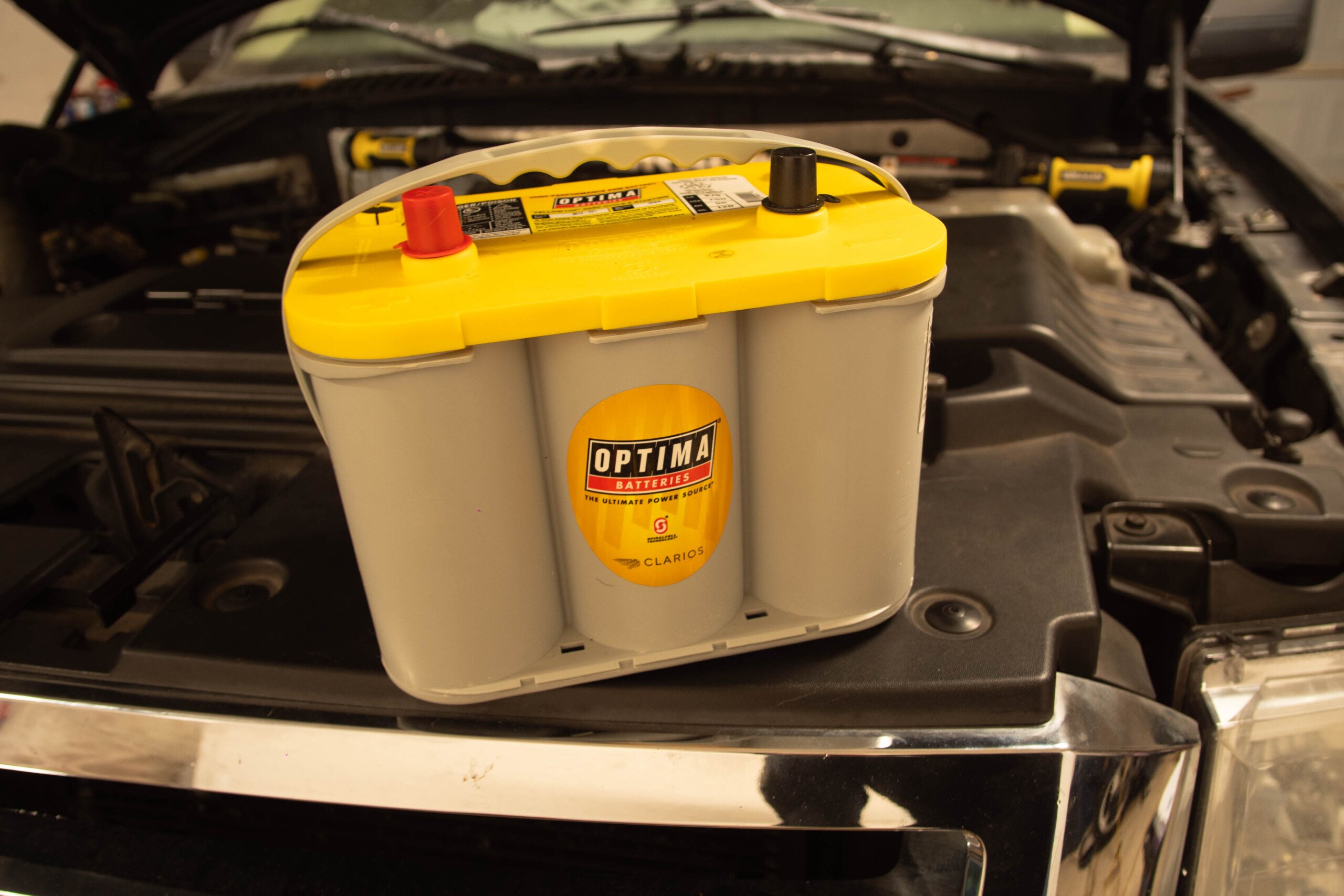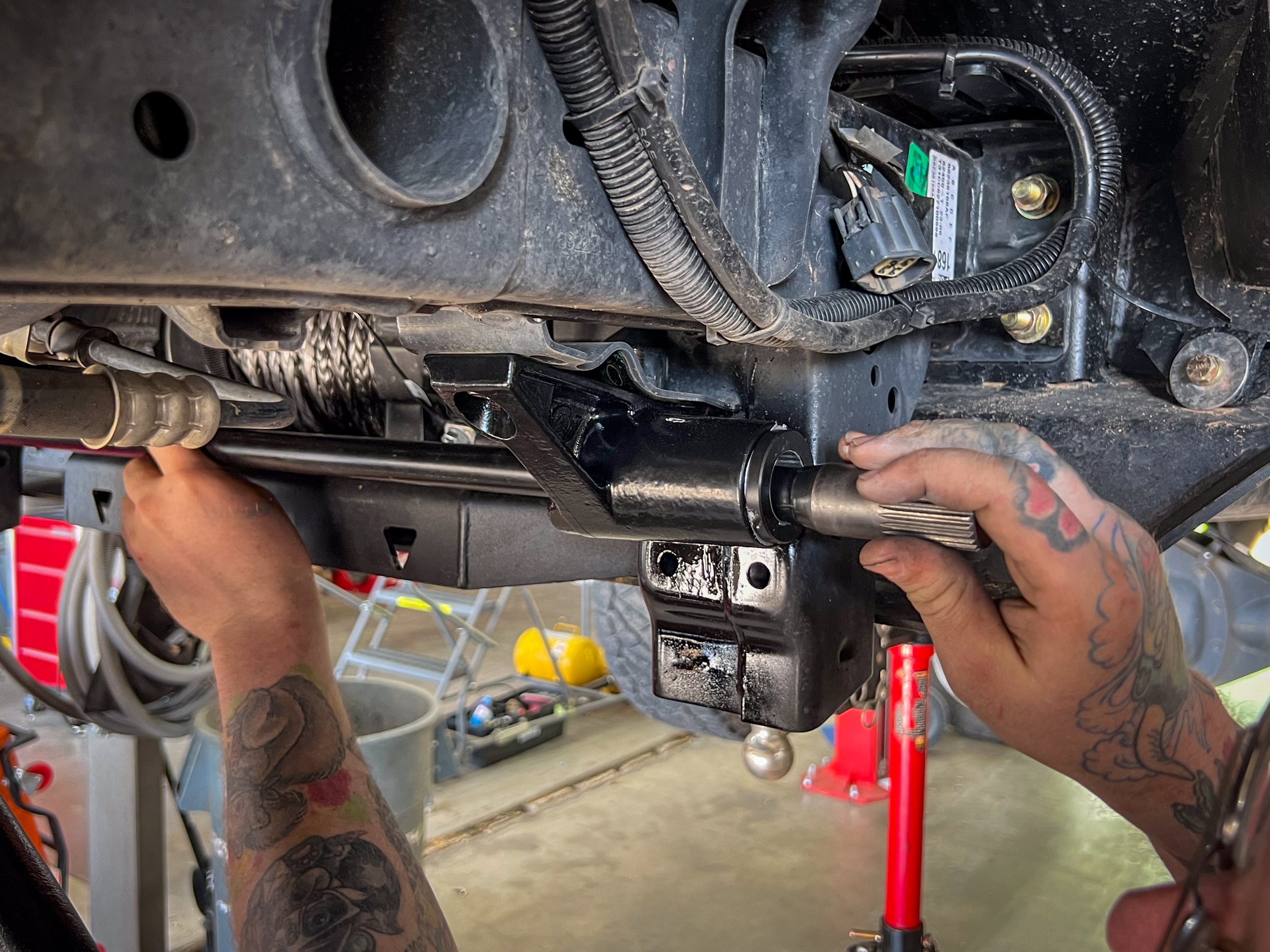When we left off, we were wrapping up day-one of the EngineLabs Giveaway Engine build live at the 2023 PRI Show. This 1,200-horsepower Gen-III HEMI engine is packed full of some of the best parts in the industry thanks to Summit Racing, all in the quest for an easy 1,200-horsepower dyno pull, before giving the engine away to a lucky entrant in the giveaway.
Starting Thursday, Late Model Engines’ Vinnie Monighetti expertly assembled the Mopar live on the show floor, right in the Power Automedia booth. As Friday rolled in we started putting together the top end of the engine and valvetrain, along with the piece de resistance, the monster Whipple Gen-6 3.8-liter twin-screw supercharger. But, before that could happen, the top end of the engine needed to be installed.
Killer Flow From Modern HEMI Heads
For this application, we obviously went with a head stud kit from ARP over standard head bolts. Between the 190,000 psi rating of the 8740 steel the studs are made from, and the inherent clamping benefits offered by a stud, our heads should easily hold up to the cylinder pressures we’ll be making with this combo. Sealing the heads to the block are a set of .054-inch-thick Cometic MLX head gaskets. The MLX line adds an additional layer in the MLS stack to prevent the yielding of the combustion seal, along with a number of coatings and embossments to seal the water passages.

The Cam Motion VVT camshaft uses the factory VVT cam sprocket, albeit with a cam phaser lockout installed, while providing both extra lift and duration, with a minimum of overlap, to keep all the cylinder pressure where it is most useful.
The heads we chose for this combination are a set of the Thitek GenIIIH “Bear” cylinder heads. Cast from 356-T6 aluminum, the castings are an entirely bespoke design, created by Thitek. The casting has an increased deck thickness to handle more combustion pressure without worry, as well as increased port-wall thickness. The heads have reinforced rocker arm stands and are interchangeable from left to right.

The Thitek GenIIIH “Bear” cylinder heads are completely unique castings, with Thitek’s proprietary CNC chamber, intake, and exhaust port designs.
They come with bronze valve guides and ductile-iron valve seats. This set of heads features Thitek’s 205cc intake porting program, which uses a 2.165-inch stainless steel intake valve and a 1.650-inch exhaust valve, both with a five-angle valve job, housed inside of Thitek’s 72cc “softened” chambers. Thitek advertises the 205cc program as increasing airflow by 100 cfm over stock, while the exhaust design flows 50 cfm over the stock port. These features will all combine with the copious amounts of boost to not just make the power, but hold up to the power, reliably.
The 205cc intake port program (left) from Thitek is said to improve flow 100 cfm over the stock 6.4-liter ports, while the Thitek exhaust port design (right) is good for 50 cfm over the stock exhaust port.
1,200-Horsepower HEMI Valvetrain
Managing the airflow for 1,200 horsepower can be a tricky task. While it might seem like cramming air in at twice atmospheric pressure would make the finer details of the valve timing less important, the opposite is true. Besides needing a perfectly timed ballet of intake and exhaust opening and closing events, you need robust parts to handle all the extra pressure and forces being generated.

These Johnson short-travel lifters look like simple factory replacement units, but the greatly reduced travel improves their performance significantly.
To manage the dance, we turned to Cam Motion. We’ll be locking out the Gen-III HEMI’s variable valve timing on this build, so we started with their VVT cam-phaser lockout kit. From there, Cam Motion spec’d out a .390-inch intake lobe with 242 degrees of duration at .050 inch lift. On the exhaust, the lobe chosen has .389 inch of lobe lift, with 254 degrees of duration at .050 inch of lift. With our chosen rocker system, that equates to .670 inch of valve lift on the intake and .653 inch of lift at the exhaust valve. A wide lobe separation angle of 116 degrees is aimed directly at not leaking boost from the twin-screw out of the exhaust, and has four degrees of advance ground into the cam.
Riding on those cam lobes are a set of Johnson Lifters’ short-travel lifters, but in a drop-in style lifter, using the OEM lifter tray to prevent rotation. With more than 50 percent less plunger travel, the short-travel lifters provide a much more accurate translation of the cam’s rotational motion into vertical motion for the pushrods. Riding on top of the hydraulic lifters is a set of Cam Motion 3/8-inch diameter, .080-inch-thick-wall pushrods. The Gen-III HEMI pushrods are different lengths, with a 6.975-inch pushrod being used on the intake side, and an 8.250-inch pushrod length being used on the exhaust side.

Cam Moton also supplied the 3/8-inch-diameter, .080-inch wall-thickness pushrods and the valvespring upgrade.
Translating the motion from the pushrod to the valve is a killer set of Jesel rocker arms. Made from 4340 steel forgings, originally designed for the Drag Pak Challenger program, the rockers rotate on bronze bushings and retain proper factory geometry, making them a truly bolt-on affair. The roller-bearing tips minimize friction and maximize the translation of motion, while a set of Stanke Motorsports Gen-3 rocker shaft stabilizers provide an extra layer of rigidity to the factory shaft system by tying both shafts together at multiple points. The Stanke rocker shaft collars prevent any unwanted rocker arm movement and ensure perfect geometry.
We upgraded the factory shaft rockers with Jesel's new steel bolt-on rocker system, which includes the Stanke Motorsports shaft braces, making everything extra rigid.
Making Big Boost With Whipple
Providing what might be the most visually imposing component of this build is Whipple Superchargers. Long-known for their efficient twin-screw superchargers, the supercharger they provided for this build is so new, that this was the first look the public got at one. The new Gen-6 design improves intercooler-core and housing airflow efficiency, and to make all the boost, Whipple chose the larger 3.8-liter displacement option. The Gen-6 4/3 rotor configuration features an upgraded rotor design to increase efficiency across the Gen-6 lineup, not just in the 3.8-liter variants.

Nothing says “big power” like a giant twin-screw Whipple supercharger with a throttle body you can easily fit your arm in. The Gen-6 3.8-liter version has improved airflow, improved intercooler cores, and is going to be an absolute beast. Dustin Whipple says they have had to put engineering effort into making the blower sound more pleasing to the ear of aftermarket enthusiasts, as all Whipple’s OE contracts demand intensive NVH compliance.
This supercharger will not just make the power we’re looking for, but will do it with ease. In fact, Dustin Whipple came by the booth and did some quick math, telling us that we might want to switch from the 10-percent overdrive ATI Super Damper to a standard-sized shell, if we are only looking for 1,200 horsepower. The 10-rib blower drive pulley should combat belt slip, and the 3.750-inch diameter is almost the maximum that will fit nestled next to the housing. So reduction in boost will need to come from the crank pulley.
In order to support the massive airflow that will be generated by the orange-powdercoated behemoth, Whipple included its massive 120mm electronic throttle body. 120mm sounds large, but once you get up close and personal with it, and realize your whole arm fits in it, the sense of scale really sets in. Inside the supercharger housing are extra thick intercooler cores, designed to make sure to keep all the charge air cool and dense.
The revised Gen-6 rotors are in a 4/3 configuration, and should make boost more efficiently than the previous Gen-5 design. The 10-rib 3.750-inch blower pulley is only one-step down from the physically largest that will fit on the blower, but still might require a smaller crank pulley to keep the engine to "just" 1,200 horsepower.
Wrapping Up The Giveaway Engine Build
Topping off the cylinder heads and valvetrain are a set of LME’s billet aluminum Gen-III HEMI valve covers. These are so new, ours are numbers 1 and 2 to come off the CNC machine, with number 3 on display in LME’s booth. Those three valve covers make up the entirety of the LME billet HEMI covers in existence at the time of writing this — talk about exclusivity. We then screwed 16 Brisk Silver RR10S spark plugs into the heads (which are significantly colder than the OE heat range) and topped them off with Performance Distributors‘ Sultans Of Spark coil packs, which are advertised to provide 40,000 volts, or 20-percent more than the OE coils.
Those Sultans Of Spark coils might look a little wide, because each coil pack fires a pair of plugs — 16 in total. The Brisk Silver plugs will be right at home keeping all the cylinders lit at full boost.
To provide fuel to this combination, Whipple supplies a set of billet aluminum fuel rails. Into those rails, we fit a set of Fuel Injector Clinic Hellcat 1,440cc high-impedence fuel injectors. Designed to be compatible with all types of fuel, the FIC injectors come with plug-and-play injector data for Dodge ECUs and should be enough for our 1,200-horsepower goal on 93 -octane gas with Boostane, while still providing solid idle quality in whatever the winner puts the engine into.
The Whipple billet fuel rails and Fuel Injector Clinic 1,440cc/min injectors should be more than capable of feeding our 1,200-horsepower goal on gasoline. We'll be using 93-octane pump gas, treated with Boostane additive.
Powermaster Performance supplied one of their modern Gen-III HEMI alternators designed to provide high amperage at idle, in order to feed the demands of a modern EFI engine while it sits at a stoplight. They also showed us their prototype HEMI starter, which we didn’t get to keep, but will be sent along with the engine to the winner (a production version, not the prototype).
As the show started to wind down on Saturday, our complete giveaway engine was wheeled out of its assembly area, and put on full display for showgoers. Once the show ended, we wheeled the engine back to LME’s booth, where they loaded it onto the truck, and drove it the 16 hours to the shop, and it now sits, awaiting its turn on the dyno after the holidays.

The Powermaster alternator is a direct-fit unit that offers significantly upgraded electrical performance, both at idle and at full song. The starter is a prototype unit, but a production unit will be sent to the winner with the engine.
If you haven’t yet entered to win this engine, head over to EngineLabsGiveaway.com to get entered (and, here’s an additional entry for reading all the way to the end — TWINSCREW). Also, make sure to like and subscribe to both the EngineLabs and Power + Performance YouTube channels for more videos on the giveaway engine, and stay tuned here, as the next time you see this engine, it will be on LME’s engine dyno making some serious power.
The 2023 EngineLabs’ Engine Giveaway is presented by Summit Racing and made possible thanks to partnerships with Late Model Engines, AMSOIL, Automotive Racing Products, ATI Performance Products, BendPak, BOOSTane, Brisk Racing, Callies Performance Products, Cam Motion, Cometic Gaskets, Diamond Pistons, Fuel Injector Clinic, Jesel Valvetrain, Johnson Lifters, King Engine Bearings, Kooks Custom Headers, Melling, Milodon, Performance Distributors, Powermaster Performance, Thitek, Total Seal, and Whipple Superchargers.

The giveaway engine is complete and ready to head back to LME to wait its turn on the dyno. And would you look at that, there’s a code for another free entry into the giveaway.













